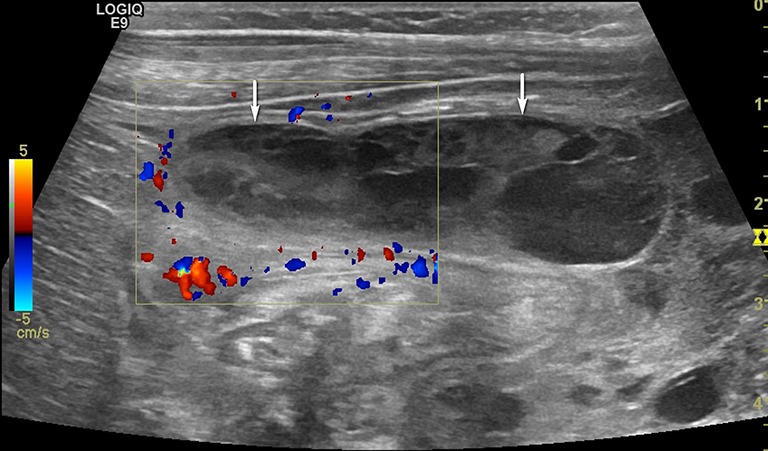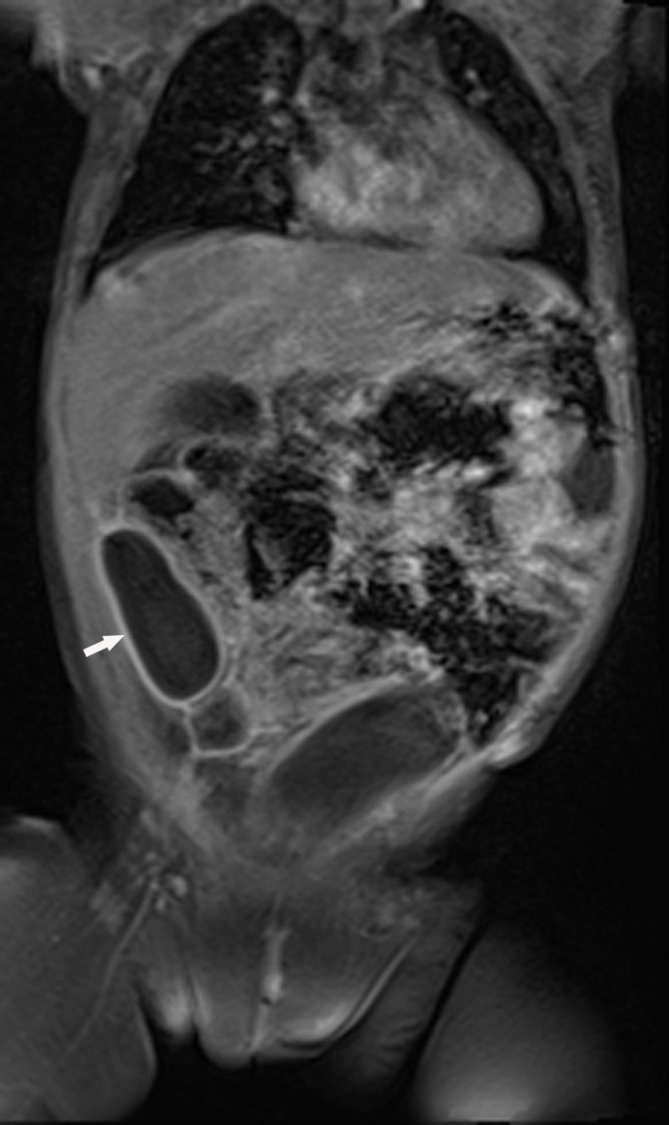Description
An 8-month-old female infant presented with a 2-day history of vomiting, diarrhoea and fever. Physical examination revealed a painful right abdomen. Laboratory tests showed a C-reactive protein of 140 mg/L (normal: <6 mg/L) and a white blood cell count of 12.8×109/L (normal: 4–15×109/L). Ultrasound of the abdomen revealed a paracolic cystic mass of 1.4×5 cm with septations from the lower part of the liver into the right fossa with no signs of volvulus or intussusception (figure 1). Abdominal CT confirmed the cystic mass and revealed signs of infection. MRI of the abdomen suggested an enteric duplication cyst as the most likely diagnosis (figure 2).
Figure 1.

Ultrasound: encapsulated tubular mass with predominant hypoechoic heterogeneous echogenicity under the right lobe of the liver.
Figure 2.

MRI coronal T1-weighted image with intravenous contrast: tubular cystic mass with thick wall ventral and lateral of the ascending colon.
Treatment with intravenous amoxicillin–clavulanic acid and painkillers was started. Laparotomy was scheduled a few days later, and a bowel-like mass was found, which did not connect with the gastrointestinal tract and its mesentery. Histopathology showed an enteric duplication cyst with colonic mucosal lining. She was discharged 5 days after surgery.
Enteric duplications are non-malignant, rare (1:4500) congenital anomalies that may vary greatly in presentation, size, location and symptoms. They are characterised by the following three features: a well-developed coat of smooth muscle, lined with a mucous membrane and found along (and often intimately attached to some portion of) the gastrointestinal tract.1 They are most frequently found in the small intestine (44%) and colon (15%), but can also be found in gastric (7%), duodenal (5%), rectal (5%), thoracic and thoracoabdominal (4%), cervical (rare) or pyloric (extremely rare) localisations.2 They arise during early embryonic development, but true aetiology remains unknown. Enteric duplications can be single or multiple, spherical or tubular, isolated or fistulated. They are discovered incidentally or present as a (painful) palpable abdominal mass. Complications are rare, but may include bleeding and infection, or manifestation as an acute intestinal obstruction. Malignant transformation has been described.
Management of asymptomatic cysts is usually expectant. When symptomatic, duplication cysts can be treated endoscopically or surgically. Associated anomalies are common; screening is appropriate.3
Thus, infected enteric duplication cysts are rare, but should be considered in the differential diagnosis of unidentified abdominal mass with signs of obstruction and/or infection. Excision of the cyst is much easier and safer after antibiotic treatment of the infection.
Learning points.
Infected enteric duplication cysts are rare.
They should be considered in the differential diagnosis of unidentified abdominal mass with signs of obstruction and/or infection.
Excision of the cyst is much easier and safer after antibiotic treatment of the infection.
Footnotes
Contributors: LMvZ: literature search, selection of appropriate images, drafting of the manuscript and approval for submission. MW: reviewing of the manuscript and approval for submission. MR: reviewing of the manuscript and approval for submission. BOdB: selection of appropriate images, reviewing of the manuscript and approval for submission.
Competing interests: None declared.
Patient consent: Obtained from guardian.
Provenance and peer review: Not commissioned; externally peer reviewed.
References
- 1. Lund DP. Alimentary tract duplications : Coran AG, Pediatric Surgery. 7th edn USA: Elsevier, 2012:1155. [Google Scholar]
- 2. Rasool N, Safdar CA, Ahmad A, et al. Enteric duplication in children: clinical presentation and outcome. Singapore Med J 2013;54:343–6. doi:10.11622/smedj.2013129 [DOI] [PubMed] [Google Scholar]
- 3. Ildstad ST, Tollerud DJ, Weiss RG, et al. Duplications of the alimentary tract. Clinical characteristics, preferred treatment, and associated malformations. Ann Surg 1988;208:184–9. [DOI] [PMC free article] [PubMed] [Google Scholar]


